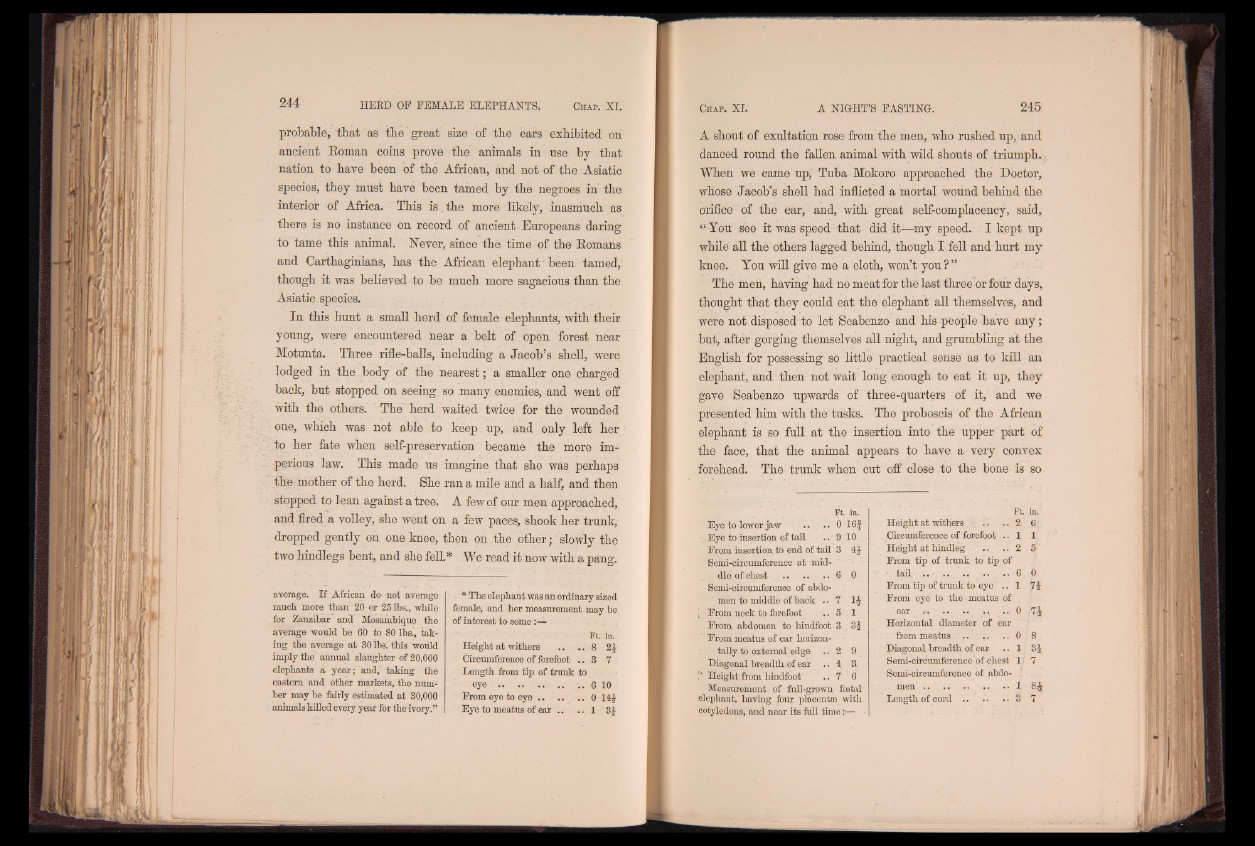
probable, tbat as the great size of the ears exhibited on
ancient Roman coins prove the animals in use by that
nation to have been of the African, and not of the Asiatic
species, they must have been tained by the negroes in the
interior of Africa. This is the more likely, inasmuch as
there is no instance on record of ancient Europeans daring
to tame this animal. Never, since the time of the Romans
and Carthaginians, has the African elephant been tamed,
though it was believed to be much more sagacious than thè
Asiatic species.
In this hunt a small herd of female elephants, with their
young, were encountered near a belt of open forest near
Motunta. Three rille-balls, including a Jacob’s shell, were
lodged in the body of the nearest; a smaller one charged
back, but stopped on seeing so many enemies, and went off
with the others. The herd waited twice for the wounded
one, which was not able to keep up, and only left her
to her fate when self-preservation became, the more imperious
law. This made us imagine that she was perhaps
the mother of the herd. She ran a mile and a half, and then
stopped to lean against a tree. A few of our men approached,
and fired a volley, she went on a few paces, shook her trunk,
dropped gently on one knee, then on the other; slowly the
two hindlegs bent, and she felL* We read it now with a pang.
average. If African do not average
much more than 20 or 25 lbs., while
for Zanzibar and Mosambique the
average would be 60 to 80 lbs, taking
the average at 30ibs. this would
imply the annual slaughter of 20,000
elephants a year; and, taking the
eastern and other markets, the number
may be fairly estimated at 30,000
animals killed every year for the ivory.”
* The elephant was an ordinary sized
female, and her. measurement may be
of interest to some
Ft. In.
Height at withers .. . . 8 2J
Circumference of forefoot .. 3 7
Length from tip of trunk to
eye .. .. ». .. .. 6 10
From eye to eye .. .. .. 0 14§
Bye to meatus of ear .. .. 1 3 |
A shout of exultation rose from the men, who rushed up, and
danced round the fallen animal with wild shouts of triumph.
When we came up, Tuba Mokoro approached the Doctor,
whose Jacob’s shell had inflicted a mortal wound behind the
orifice of the ear, and, with great self-complacency, said,
“ You see it was speed that did it^m y speed. I kept up
while all the others lagged behind, though I fell and hurt my
knee. You will give me a cloth, won’t you ? ”
The men, having had no meat for the last three or four days,
thought that they could eat the elephant all themselves, and
were not disposed to let Seabenzo and his people have any;
but, after gorging themselves all night, and grumbling at the.
English for possessing so little practical sense as to kill an
elephant, and then not wait long enough to eat it up, they
gave Seabenzo upwards of three-quarters of it, and we
presented him with the tusks. The proboscis of the African
elephant is so full at the insertion into the upper part of
the face, that the animal appears to have a very convex
forehead. The trunk when cut off close to the bone is so
Ft. in.
Height at withers g .. • ■ 2 6
Circumference of forefoot .. 1 1
Height at hindleg .. .. 2 5'
From tip of trunk to tip of
tail .. .. .. .. •• 6 0
From tip of trunk to eye . . 1 7i
From eye to the meatus of
ear 0 .7J
Horizontal diameter of ear
from meatus .. .. . . 0 8
Diagonal breadth of ear- .. 1 3 $
Semi-circumference of chest 1> 7
Semi-circumference of abdomen
.. .. .................. 1 8 J
Length of c o r d .............. 3 7
Ft. in.
Eye to lower jaw .. .. 0 16 J
Bye to insertion of tail , . 9 10
From insertion to end of tail 3 4J
Semi-circumference at middle
of chest ¡J.....................6 0
Semi-circumference of abdomen
to middle of back .. 7 1J
| From neck to forefoot I . . 5 1
From abdomen to liindfoot 3 3J
From meatus of ear horizontally
to external'edge . . 2 9
Diagonal breadth.of ear .. 4 3
!‘ Height from hindfoot .. 7 6
Measurement of full-grown foetal
elephant, having four placentas with
cotyledons, and near its full time:— •